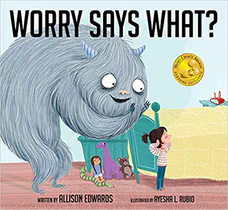Worry Says What
Written by Allison Edwards
Illustrated by Ayesha L. Rubio
32 pages
•
Published 2018 (National Center for Youth Issues)

Recommended Age Range: Kindergarten through 3rd grade.
Publisher's Summary:
Allison Edwards, author of the best-selling book Why Smart Kids Worry, gives a glimpse into the ways worry whispers to young minds, and offers a powerful tool all children can use to silence those fears.

Dr. Annie's Takeaways
Recommended for: Introduces the concept of a Worry Monster to help children start to identify their worries and recognize that they probably aren’t the truth. Helps a child to start challenging their worries with self-affirmations and engagement in feared activities. The Worry Monster intervention is widely used by therapists to help children to address worries. Children who have some insight into their worries (and can put them into words) will likely benefit from reading this book.
Would a child like it? A child with their own Worry Monster will likely connect with this story and feel heartened by the effectiveness of the intervention. The story is cute, not-at-all dark, and normalizing for a kid with a lot of worries.
Evidence-Based Practices:
Cognitive Restructuring
Tone: Upbeat, encouraging
Story Quality: This story is straight-forward yet big-hearted. A girl has a Worry (pictured as a kind-of-cute fuzzy, gray monster) who tells her things that “always [make her] feel worse,” such as “You can’t do it” and “They don’t like you.” She realizes that listening to Worry never makes her feel better, and she starts talking back to Worry and telling herself “what is true.” The more she reminds herself that Worry isn’t telling her the truth, the smaller and smaller Worry gets. The girl’s worries will likely be relatable to many children, and her triumph over Worry will likely inspire many worriers to stand up to their own Worries.
Illustrations: Attractive, colorful illustrations (I think they’re colored pencil and watercolor). Worry is pictured as a fairly cute, fuzzy gray monster who shrinks over the course of the book.
Representation: The girl is White with dark brown hair. The Worry is referred to with he/him pronouns. The girl’s classmates and friends are boys and girls who are White, Brown, and Black. The girl is a gymnast, and boys and girls are pictured as her teammates.
Psychological Practices: This book is a great resource for teaching children to externalize their worries (in the girl’s case, she has worries about tests, friends, gymnastics, and nighttime) in order to identify them and talk back to them. It introduces the idea of a Worry Monster, and teaches children that the more they remind their Worry Monsters that what it is saying isn’t the truth, the smaller their worries will get. It shows the girl using positive self-talk (e.g., “I have lots of friends,” “I believe in myself”) and doing things that the Worry didn’t want her to do (e.g., asking a friend to play at recess, trying a difficult move in gymnastics). There is a nice moment when she tries the difficult move in gymnastics and isn’t able to do it at first. Worry comes back strongly and she has to remind him that she just isn’t able to do it “yet.” The book ends with an acknowledgement that Worry will come back now and then, but she’ll be ready for him when he does. Following a read-through of this book, I’d likely encourage a child to draw their own Worry Monster with speech bubbles of what their Worry tells them, followed by a self-portrait with speech bubbles of the child talking back to the Worry like the girl in this story does.
Concerns: The Worry Monster is pictured as a traveler who sets up camp (pictured as a tent and a campfire) with a child in order to make them worry. There’s nothing concerning to me about this. What gives me pause is that the Worry arrives and leaves carrying his belongings in a bag on a stick, which touches on an offensive trope used to depict unhoused people. It’s a small piece of the story, but I wish it were different.
